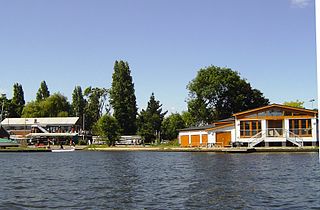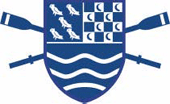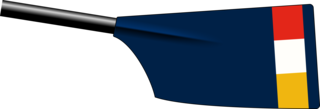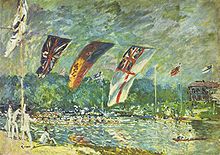
Rowing, sometimes called crew in the United States, is the sport of racing boats using oars. It differs from paddling sports in that rowing oars are attached to the boat using oarlocks, while paddles are not connected to the boat. Rowing is divided into two disciplines: sculling and sweep rowing. In sculling, each rower holds two oars—one in each hand, while in sweep rowing each rower holds one oar with both hands. There are several boat classes in which athletes may compete, ranging from single sculls, occupied by one person, to shells with eight rowers and a coxswain, called eights. There are a wide variety of course types and formats of racing, but most elite and championship level racing is conducted on calm water courses 2 kilometres (1.2 mi) long with several lanes marked using buoys.

Henley Royal Regatta is a rowing event held annually on the River Thames by the town of Henley-on-Thames, England. It was established on 26 March 1839. It differs from the three other regattas rowed over approximately the same course, Henley Women's Regatta, Henley Masters Regatta, and Henley Town and Visitors' Regatta, each of which is an entirely separate event.
Boat racing is a sport in which boats, or other types of watercraft, race on water. Boat racing powered by oars is recorded as having occurred in ancient Egypt, and it is likely that people have engaged in races involving boats and other water-borne craft for as long as such watercraft have existed.

The Head of the River Race (HORR) is an against-the-clock ('processional') rowing race held annually on the River Thames in London, England between eights, other such races being the Schools' Head of the River Race, Women's Head of the River Race and Veterans' Head of the River Race. Its competitors are, with a few experienced junior exceptions, seniors of UK or overseas competitors and it runs with the ebb tide down the 4.25 mile (6.8 km) Championship Course from Mortlake to Putney which hosts the Oxford and Cambridge head-to-head races usually between one and two weeks later.

The Championship Course is a stretch of the River Thames between Mortlake and Putney in London, England. It is a well-established course for rowing races, particularly the Oxford and Cambridge Boat Race. The course is on the tidal reaches of the river often referred to as the Tideway. Due to the iconic shape of the Championship Course, in orthopaedic surgery, an "S" shaped incision along the crease of the elbow is commonly referred to as "a boat-race incision resembling the River Thames from Putney to Mortlake."

Vesta Rowing Club is a rowing club based on the Tideway of the River Thames in Putney, London, England. It was founded in 1870.

The Henley Boat Races were a series of annual rowing races between various crews representing the University of Oxford and the University of Cambridge.
A skiff is any of a variety of essentially unrelated styles of small boats. Traditionally, these are coastal craft or river craft used for leisure, as a utility craft, and for fishing, and have a one-person or small crew. Sailing skiffs have developed into high performance competitive classes. Many of today's skiff classes are based in Australia and New Zealand in the form of 12 ft (3.66 m), 13 ft (3.96 m), 16 ft (4.88 m) and 18 ft (5.49 m) skiffs. The 29er, 49er, SKUD and Musto Skiff are all considered to have developed from the skiff concept, all of which are sailed internationally.

The Thames Rowing Club (TRC) is a rowing club based on the tidal Thames as it flows through the western suburbs of London. The TRC clubhouse stands on Putney Embankment. The club was founded in 1860.

Kingston Rowing Club (KRC) is a rowing club in England founded in 1858 and a member club of British Rowing.

Curlew Rowing Club is a rowing club based on the Tideway of the River Thames at Greenwich, London, England. It was founded in 1866 and has been in Greenwich without interruption for over 130 years, though not always called Curlew.

Skiffing refers to the sporting and leisure activity of rowing a Thames skiff. The skiff is a traditional hand built clinker-built wooden craft of a design which has been seen on the River Thames and other waterways in England and other countries since the 19th century. Sculling is the act of propelling the boat with a pair of oars, as opposed to rowing which requires both hands on a single oar.
Peter Herbert "Jacko" Jackson was an English rower who competed at the 1936 Summer Olympics.

Walbrook Rowing Club, colloquially sometimes named Teddington Rowing Club, is a rowing club, on the River Thames in England on the Middlesex bank 800 metres above Teddington Lock next to Trowlock Island, Teddington. It is the lowest club on the weir-controlled Thames and is the organising club for Teddington Head of the River Race held in November for all classes of racing shells.

Putney Town Rowing Club (PTRC) is a rowing club on the Tideway, the tidal reach of the River Thames in England. Its official British Rowing registered colours are navy and white.

Oxford University Women's Boat Club (OUWBC) is the rowing club for female rowers who are students at the University of Oxford. The club was founded in 1926 and is now based in Wallingford at the Fleming Boat House, along with OUBC, OUWLRC and OULRC.
The Argonaut Club was an English rowing club based on the Tideway of the River Thames that competed in the middle of the 19th century.
The Thames Club was an English rowing club based on the Tideway of the River Thames that competed in the middle of the 19th century.

The St George's Club was an English rowing club based on the Tideway of the River Thames that competed in the middle of the 19th century.

King's College London Boat Club is the rowing club of King's College London based on the Tideway of the River Thames next to Chiswick Bridge, based at Tideway Scullers School boathouse, Dan Mason Drive, Chiswick, London.
















